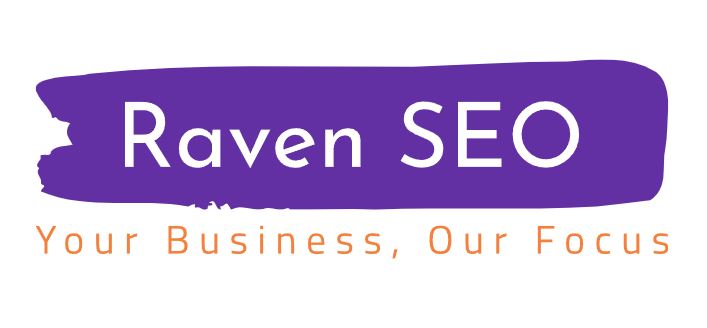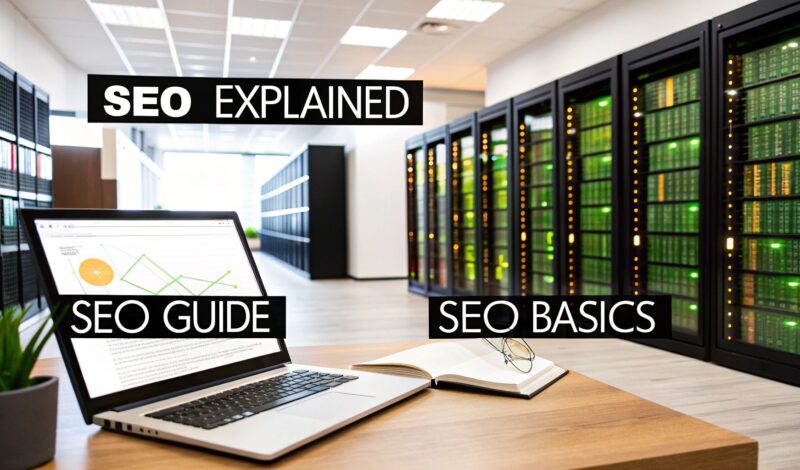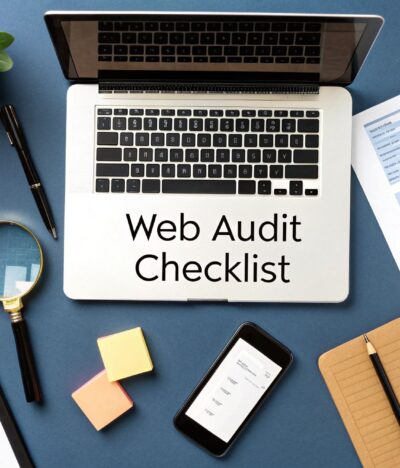Search Engine Optimization (or SEO) is the practice of increasing your website’s visibility when people search for your products or services in Google and other search engines. The higher your pages rank in search results, the more likely you are to capture attention and attract potential customers to your business.
So, What Exactly Is Search Engine Optimization?
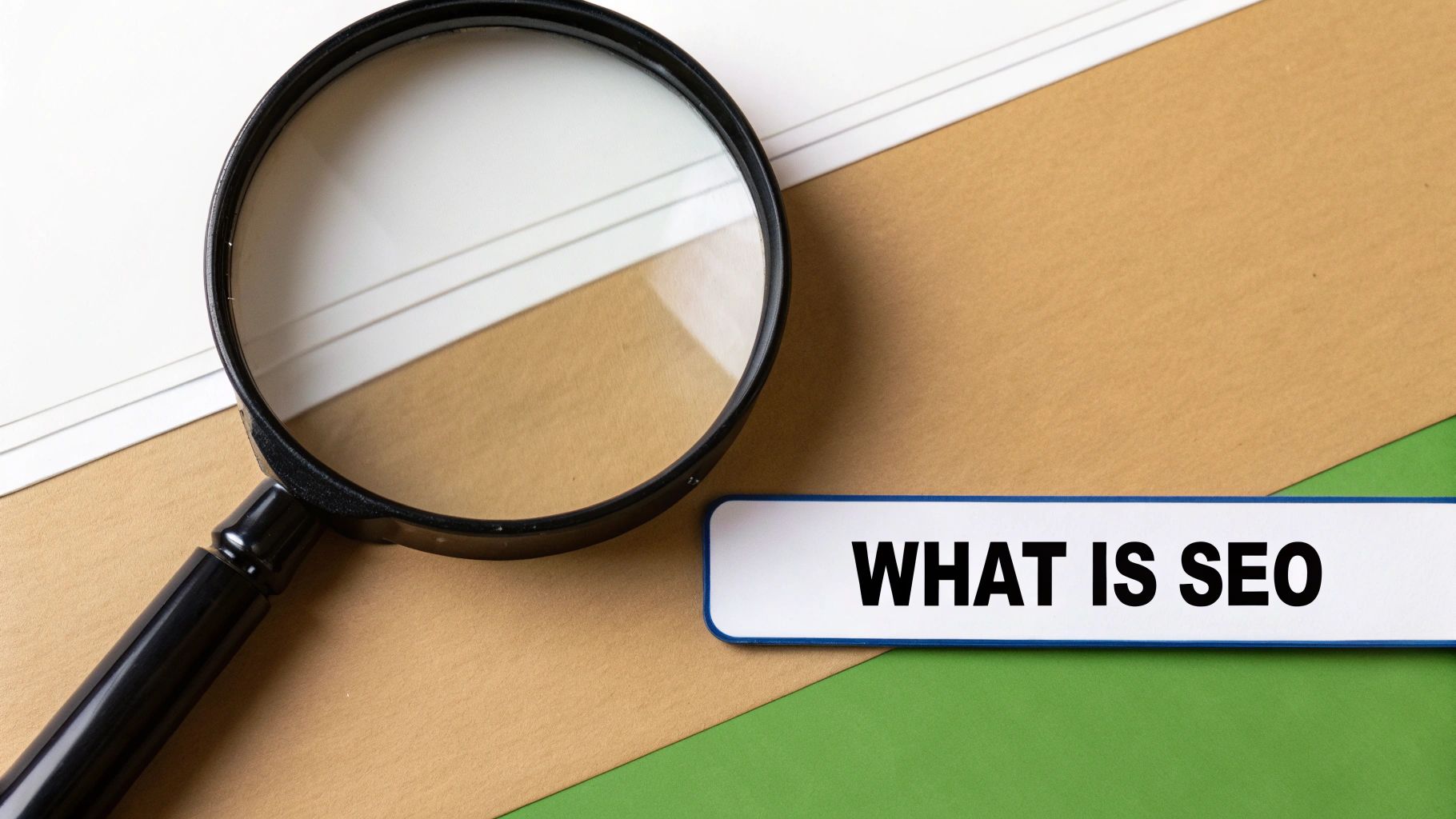
Think of Google as a massive digital library and its search engine as the world’s most efficient librarian. When you type in a question, that librarian instantly scans billions of books (websites) to find the single best answer for you.
In this scenario, your website is one of those books.
So, what is search engine optimization? It’s the art and science of making your “book” the one the librarian recommends first. It isn’t about gaming the system; it’s about making your website so helpful, clear, and trustworthy that the search engine wants to recommend it.
This means structuring your website and content in a way that search engine algorithms can easily understand, proving that you’re a relevant and reliable resource for what people are looking for.
Why It’s More Important Than Ever
Let’s be realistic: simply having a website isn’t enough anymore. The internet is a crowded place. Consider that over 90% of all online experiences begin with a search engine. Without SEO, your website is like a shop located on a back alley with no signs—it might be great, but no one will ever find it.
SEO ensures that when people are actively searching for the solutions you offer, your business is right there in front of them. It’s about connecting with an audience that is already looking for you.
This process builds a powerful foundation of trust. When your site appears high in search results, it signals to users that you are a credible and authoritative voice in your field, which naturally enhances your brand’s reputation.
The Basic Mechanics of SEO
At its heart, SEO is all about aligning your website with what search engines are designed to find and reward. It’s a combination of different activities, but they all share the same goal: making your site the best possible result for a search.
A key part of this is understanding the complete guide to web indexing, which is how search engines discover, categorize, and store information from across the web.
If this sounds a bit overwhelming, don’t worry. The language of SEO can seem like its own dialect at first. Familiarizing yourself with an SEO glossary is a great first step to understanding the terms you’ll encounter.
The Three Pillars of Modern SEO
To simplify things, it’s helpful to break down any effective SEO strategy into three core components. Think of them as the legs of a stool—you need all three for a stable and successful foundation.
Here’s a quick rundown of what they are and why each one is crucial.
| Pillar | What It Means | Why It Matters |
|---|---|---|
| On-Page SEO | This includes everything on your website that you can directly control, like your content, keywords, headlines, and HTML tags. It’s about making your content clear for both people and search engines. | This tells search engines what your content is about. Without it, they can’t understand or rank your pages correctly. |
| Off-Page SEO | These are actions taken outside of your website to impact your rankings. The biggest factor is earning backlinks—links from other reputable websites pointing to yours. | Backlinks act as “votes of confidence” from other sites, signaling to search engines that your content is trustworthy and authoritative. |
| Technical SEO | This focuses on the backend of your website to ensure it’s fast, secure, and easy for search engines to “crawl” and index. It covers things like site speed, mobile-friendliness, and site architecture. | A poor technical foundation can prevent your content from being found, no matter how good it is. It’s the engine under the hood. |
Mastering these three pillars—creating great content (on-page), building authority (off-page), and ensuring your site runs smoothly (technical)—is the key to long-term SEO success.
How Search Engines Actually Find and Rank Your Content
To truly understand what SEO is about, you need to peek behind the curtain at how search engines like Google work. It’s not magic, but it is a massive, always-on system designed to make sense of the entire internet.
This whole operation boils down to a continuous, three-step process. Search engines are constantly discovering content, storing it in a giant library, and then deciding which pages are the most helpful for any given search.
This simple flowchart shows you exactly how it works.
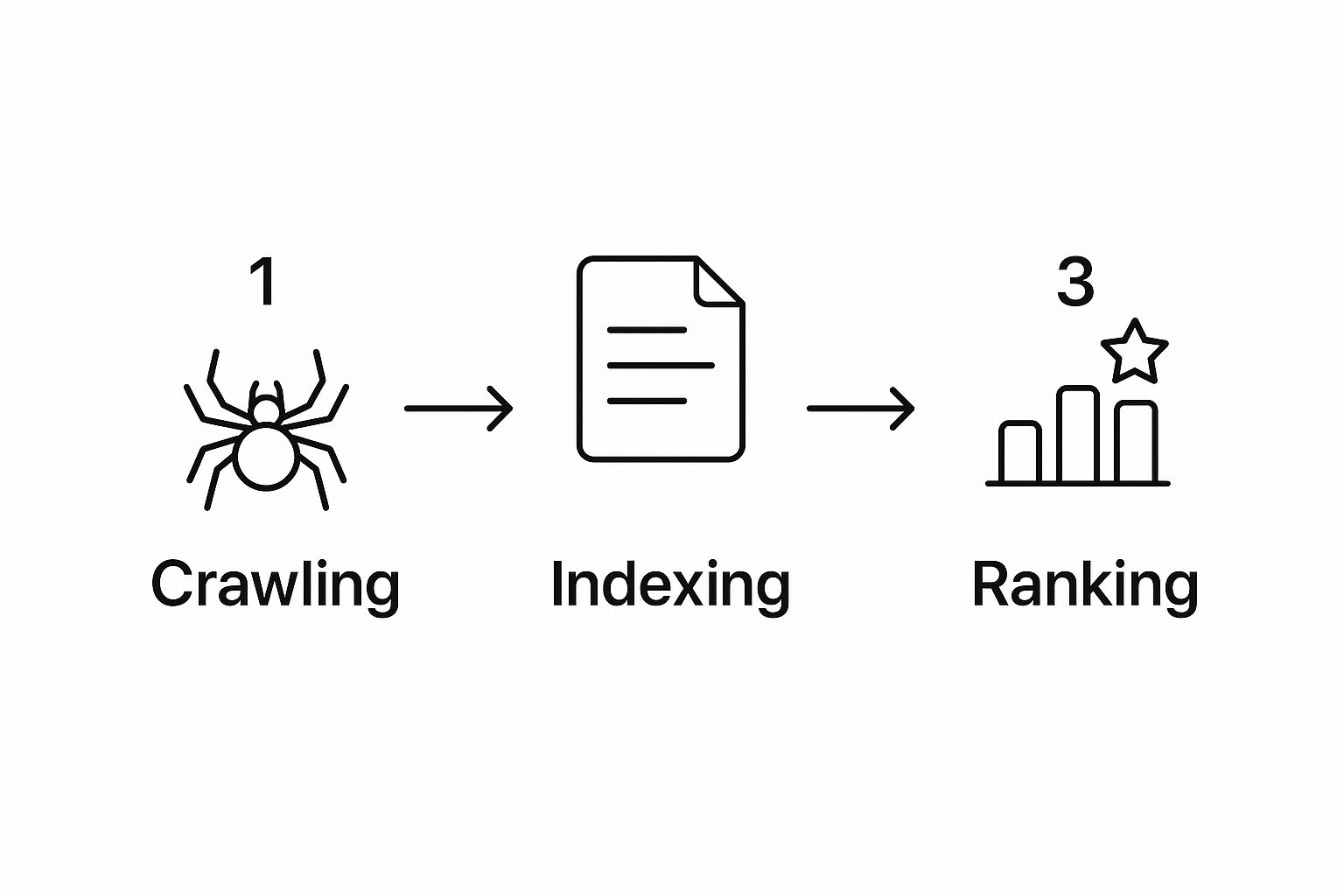
As you can see, for your page to even have a chance at ranking, it has to be crawled and indexed first. Each step is an essential prerequisite for the next.
Step 1: Crawling – The Discovery Phase
It all starts with crawling. Search engines send out automated programs, often called “bots” or “spiders,” to constantly explore the internet. These bots jump from page to page by following links, much like how you click your way through different websites.
Their sole mission is to find new and updated content. Whether you’ve just published a blog post, updated a product page, or launched a new website, these crawlers are on the hunt for fresh information. If they can’t find your content, it might as well be invisible.
Step 2: Indexing – The Filing System
After a bot finds a page, the next step is indexing. This is the analysis part. The search engine examines everything on the page—text, images, videos—to figure out what it’s all about. Then, it stores this information in a gigantic database called an index.
Think of the index as the world’s largest library. Instead of organizing books by author, it organizes trillions of web pages based on their content and topic.
A page that isn’t in the index has zero chance of appearing in search results. It’s like a book that never got put on the library shelf—no one will ever find it.
This incredible filing system is what allows a search engine to pull up relevant answers in the blink of an eye.
Step 3: Ranking – The Final Selection
Now for the part you care about most: ranking. When you type something into the search bar, the engine scans its index to pull up all the pages that could be a match. From there, it uses a highly complex algorithm—essentially a sophisticated rulebook—to sort those pages from most to least relevant.
This is where your SEO efforts come into play. The goal is to optimize for the various search engine ranking factors that the algorithm uses to make its decisions. While there are hundreds of signals, they generally fall into a few key areas:
- Relevance: How closely does your page’s content answer the intent behind the search?
- Authority: How trustworthy is your website? This is often measured by how many other quality sites link to yours.
- Quality: Is the content genuinely helpful, well-written, and comprehensive?
- Usability: Is your site easy to use? This includes mobile-friendliness and fast load times.
The algorithm weighs all these factors (and many more) to deliver what it considers the best results for a query—all in a fraction of a second.
From Keywords to a Full-Blown User Experience

In the early days, SEO was like the Wild West. Search engines were fairly basic, and the rules were easy to bend. Marketers quickly figured out they could climb the rankings by repeating keywords over and over again—a trick now known as keyword stuffing.
You would find pages crammed with awkward, unnatural text. Some even hid keywords by making them the same color as the background. And for a while, it worked. Old algorithms relied almost entirely on keyword frequency to determine a page’s topic. The downside? This created a mess of low-quality search results, which was a terrible experience for users.
The Wake-Up Call for Search Quality
Search engines like Google quickly realized they had a problem. To stay relevant, they had to deliver genuinely helpful answers, not just pages that were good at gaming the system. This kicked off a series of massive algorithm updates that completely reshaped the world of SEO.
Looking back, you can see distinct eras. It started with those primitive tactics in the early 1990s. But then came the game-changers: Google’s Panda and Penguin updates. These marked a major crackdown on thin content and manipulative links, forcing everyone to focus on quality. You can explore the full history of SEO’s evolution from simple tactics to complex strategies to see just how far we’ve come.
These updates introduced two core principles that now guide modern SEO:
- Panda (2011): This update was designed to penalize sites with low-quality, thin, or duplicated content. It was the first big push to reward websites that offered real value.
- Penguin (2012): A year later, Penguin arrived to dismantle manipulative link-building schemes. It punished sites using spammy, irrelevant, or paid links to fake their authority.
Together, Panda and Penguin sent a clear message: the days of trying to trick search engines were over. The only way to win long-term was to earn your spot by creating great content and delivering a positive user experience.
Today’s SEO Is All About Experience and Trust
That same thinking has only grown stronger with every new update. Today, search engine optimization is far less about ticking technical boxes and much more about deeply understanding the person on the other side of the screen. Google now considers hundreds of signals, like how fast your page loads, whether it works well on a phone, and how people interact with your content.
This user-first approach is built on trust. To rank well now, your site must demonstrate Experience, Expertise, Authoritativeness, and Trustworthiness (E-E-A-T). We have a whole guide that explains the power of E-E-A-T if you want to learn more.
In short, modern SEO is about proving that you’re a credible, reliable, and genuinely helpful resource.
Understanding the Core Types of SEO
Let’s get one thing straight: SEO isn’t a single activity. It’s a combination of different efforts that all work together.
Think of your website like a house. To make it the best on the block, you can’t just pick a nice paint color. You also need a solid foundation and a great reputation in the neighborhood. SEO works the same way and is generally broken down into three main categories.
These three areas—On-Page, Off-Page, and Technical SEO—are the pillars of any solid strategy. Understanding how they fit together is key to succeeding with SEO. Let’s break them down.
On-Page SEO: Your Content, Your Site
On-Page SEO includes everything you do on your own website to show search engines what your content is about and why it’s valuable. This is your chance to directly communicate relevance and quality.
It all starts with two core activities:
- Keyword Research: This is where you find the exact words and phrases your potential customers are typing into Google. It’s less about guessing and more about data-driven discovery.
- Content Creation: Once you know what people are searching for, you create high-quality, genuinely helpful content that answers their questions. This is the heart and soul of modern SEO.
Beyond the words on the page, On-Page SEO also involves optimizing elements like page titles, headers, and meta descriptions. To get a deeper look, check out this guide on what is on-page optimization. The goal is to make your content easy for both people and search engine bots to understand.
Off-Page SEO: Building Your Reputation Online
While On-Page SEO is about what’s on your site, Off-Page SEO is about building your website’s authority and credibility across the rest of the web. It essentially answers the question: “Do other websites trust and vouch for you?”
The biggest piece of the Off-Page puzzle is earning backlinks. A backlink is simply a link from another website pointing to yours.
Think of backlinks as votes of confidence. When a reputable website links to one of your pages, it’s like them giving you a public endorsement. This tells search engines that your content is trustworthy, which can give your rankings a major boost.
Other Off-Page signals include social media engagement, brand mentions on forums, and writing guest posts for other blogs. It’s all about building a strong digital reputation.
Technical SEO: The Foundation That Holds It All Together
Finally, we have Technical SEO. This is all about making sure your website’s infrastructure is sound, stable, and easy for search engines to crawl and index. If On-Page is your home’s interior design and Off-Page is your neighborhood reputation, Technical SEO is the foundation, plumbing, and electrical wiring.
Without a solid technical setup, even the best content can fail. Key areas of Technical SEO include:
- Site Speed: How fast your pages load. Slow sites are a huge turn-off for visitors, and Google knows it.
- Mobile-Friendliness: Ensuring your site works flawlessly on smartphones and tablets, where most people search today.
- Site Architecture: How your site is organized. A logical structure makes it easy for users and search engines to find what they’re looking for.
On-Page vs Off-Page vs Technical SEO
To see how these three pillars compare, here’s a quick breakdown of their goals and the kind of work involved in each.
| SEO Type | Primary Goal | Example Activities |
|---|---|---|
| On-Page SEO | Make content relevant and valuable for a target query. | Keyword research, content writing, optimizing title tags. |
| Off-Page SEO | Build authority and trust from other sites. | Link building, social media marketing, guest blogging. |
| Technical SEO | Ensure search engines can crawl and index the site easily. | Improving page speed, mobile optimization, creating an XML sitemap. |
These three types of SEO aren’t separate tasks to check off a list; they are deeply connected. Great content (On-Page) earns more backlinks (Off-Page), but neither will get you far if search engines can’t even crawl your site properly (Technical). A truly effective SEO strategy finds the right balance among all three.
Why SEO Is a Powerful Engine for Business Growth
It’s one thing to understand the mechanics of SEO, but the real “aha!” moment comes when you see how those practices translate into actual business results. SEO isn’t just a technical to-do list; it’s one of the most powerful marketing channels for building sustainable, long-term success.
Think about traditional advertising—it’s often about interrupting people. SEO is the opposite. It connects you with an audience that is actively looking for the exact solutions you offer. When someone types a question into Google, they have a real need. Showing up at the top of the results positions your business as the most credible answer right when they need it most.
This process naturally builds a level of trust that paid ads can’t easily replicate. People see organic search results as more authentic. When you consistently appear for relevant searches, you’re not just a result; you become an authority in your field, which leaves a lasting positive impression.
Attracting High-Quality Traffic
The visitors you get from search aren’t just random clicks; they are high-intent. These aren’t people casually browsing. They have a problem to solve or a product they’re ready to buy, making them far more likely to become leads and customers.
Think about it: a top ranking puts your business in front of the warmest possible audience—people who have already raised their hands and declared their interest. This is fundamentally different from pushing ads in front of people who may have no interest at all.
Delivering Long-Term Value and ROI
Here’s where SEO truly shines. When you turn off a paid ad campaign, the traffic stops instantly. But the work you put into SEO compounds over time. A well-ranking article or service page can keep attracting qualified traffic and generating leads for months, or even years, after you publish it. That’s an incredible return on investment.
The industry’s growth tells the story. By 2025, SEO is projected to be an $86.8 billion industry worldwide. That’s because businesses know that around 93% of all online experiences begin with a search engine, and over 75% of users never click past the first page. Its importance is clear. You can find more details about SEO’s impact on business on landingi.com.
And don’t forget the data. The insights you gain from SEO are a goldmine. Seeing which keywords people use and how they behave on your site gives you a direct look into your customers’ minds—their needs, pain points, and habits. This intelligence can shape your entire business strategy, making SEO an essential part of real growth.
Your First Steps into Foundational SEO

Diving into SEO for the first time can feel like trying to drink from a firehose. There are so many terms, tactics, and opinions that it’s easy to feel overwhelmed. The secret? Don’t try to do everything at once.
Instead, focus on three core areas that deliver the biggest impact. Mastering these basics will build a rock-solid foundation for everything else you do, setting you up for long-term success without needing to become a technical wizard overnight.
Understand What Your Audience Wants
The first, and most crucial, step is keyword research. Forget the old myth about stuffing random words into your pages. This is really about understanding the exact language your potential customers use when they search for the solutions you offer.
What questions are they typing into Google? What problems are they trying to solve? When you can answer that, you can create content that meets them exactly where they are. This simple alignment is the true bedrock of SEO. It’s how you ensure you’re creating content people are actually looking for.
Create Genuinely Helpful Content
Once you know the questions, your job is to provide the best answers. This is non-negotiable in modern SEO. Your goal should be to create pages that are so clear, comprehensive, and helpful that the user thinks, “This is exactly what I was looking for.”
Search engines have gotten incredibly smart over the years. Google’s introduction of its AI-powered RankBrain in 2015 was a huge turning point. It officially shifted the game from “who can use the most keywords” to “who is best satisfying the user’s intent.” That focus on quality and user experience is more important today than ever. You can learn more about the history and future of SEO on opositive.io.
Key Takeaway: Stop writing for search engines. Start writing for the human on the other side of the screen. When you solve their problem, you’re doing great SEO.
Ensure a Flawless Mobile Experience
Finally, your website must work perfectly on a smartphone. Period. With the majority of Google searches now happening on mobile devices, a clunky, slow, or hard-to-read site is a deal-breaker.
A poor mobile experience doesn’t just frustrate visitors and send them running to a competitor; it also sends a massive red flag to Google that your site isn’t user-friendly.
Nailing these three fundamentals—understanding your audience, creating amazing content, and optimizing for mobile—gives you a powerful and practical starting point for your entire SEO strategy.
A Few Common Questions About SEO
Even with the basics down, you probably still have some questions. That’s completely normal. Let’s tackle a few of the most common ones that come up when people are just getting started with SEO.
Getting these cleared up will help you set the right expectations and feel more confident as you put these ideas into practice.
How Long Does It Take to See SEO Results?
This is probably the number one question everyone asks, and the honest answer is: it’s a marathon, not a sprint. While you might see small improvements quickly, you should plan on seeing meaningful results in about four to twelve months.
Why so long? It depends on a few things: how competitive your industry is, how much authority your website already has, and how consistently you work on it. Think of it as a long-term investment. You’re building an asset that grows over time, unlike paid ads that vanish the second you stop paying.
Can I Actually Do SEO Myself?
Yes, you absolutely can! Many small business owners handle their own SEO, especially at the beginning. You can get great results by just sticking to the fundamentals.
Focus on creating genuinely helpful content that answers the real questions your customers are asking. Make sure your website works well on a phone. These foundational steps can make a huge difference.
The trick is to start with the basics you can manage yourself and be patient. As your business grows, you can always bring in an expert to tackle the more complex parts.
Is SEO Better Than Running Paid Ads?
This is a classic debate, but it’s not really an “either/or” choice. SEO and paid search ads, like Google Ads, are two different tools that work best when used together.
Here’s a simple way to think about it:
- SEO (Organic Search): This is how you build lasting trust and earn “free” traffic over time. It’s a slow burn, but once you start ranking, the return on your initial effort can be incredible.
- Paid Ads (PPC): This is your shortcut to the top. It gets you instant visibility from day one, which is perfect for testing a new product or driving traffic for a specific campaign. The downside? The traffic stops the moment you turn off your ad spend.
A smart approach uses both. You can run paid ads to get immediate traffic while your SEO strategy builds up steam in the background, creating a powerful, sustainable engine for growth.
Ready to build a powerful online presence that drives real growth? The team at Raven SEO offers tailored strategies to increase your visibility, traffic, and conversions. Start with a no-obligation consultation to map out your success.
